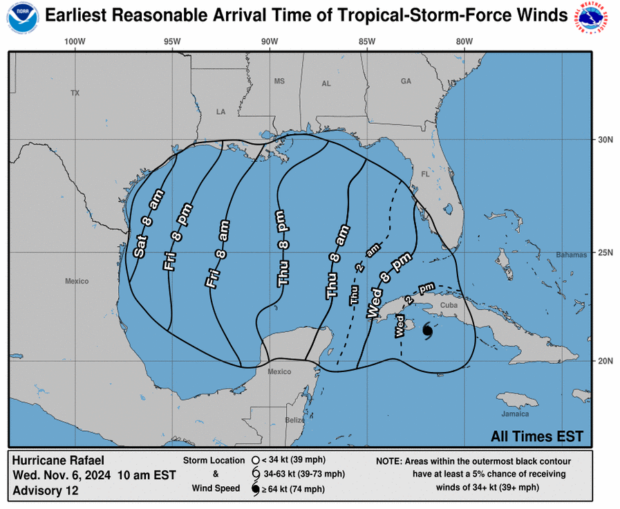Hurricane Rafael hit Category 2 strength and will likely intensify further as it churns north towards western Cuba on Wednesday, the National Hurricane Center said, packing sustained winds of 110 mph (175 kph) as it neared the Caribbean island’s southern shore by mid-morning.
The hurricane was located about 130 miles (205 km) southeast of Cuba’s capital Havana at 10 a.m., with strong winds and rain already lashing Cuba’s Isle of Youth.

“It appears very likely that Rafael will become a major hurricane before it makes landfall in western Cuba later today,” the NHC said.
Hurricanes reaching Category 3 and higher are considered major hurricanes because of their potential for significant loss of life and damage.
Rafael strengthened into a Category 1 hurricane overnight as it grazed the Cayman Islands, causing widespread power outages and flooding. Heavy rains had earlier hit parts of Jamaica.
The NHC warned of life-threatening storm surge, damaging hurricane-force winds and flash flooding in western Cuba through Wednesday.
Cuba’s government on Tuesday began evacuating residents from low-lying areas, particularly on the island’s south coast, where officials warned of heavy rains, wind and a life-threatening storm surge.
Authorities closed airports across western Cuba ahead of the storm, grounding flights at both Havana’s Jose Marti airport as well as at the popular beach resort at Varadero through Thursday.
Schools were closed across the island and all public transportation in Havana has been shut down until after the storm’s passage.
Farmers fast-tracked the harvest of ripening fruits and vegetables across much of western Cuba, and officials had moved to protect 8,000 tonnes of tobacco in Pinar del Rio province, the agriculture minister said.
The timing could not be worse for the Communist-run island, which last month suffered a total collapse of its national electric grid, leaving an estimated 10 million people without power for several days.
Hurricane Oscar made landfall in far eastern Cuba around the same time as the blackout, throwing a one-two punch that has sapped precious resources in a country suffering from severe shortages of food, fuel and medicine.
Continuing rolling blackouts, crippled communications and fuel shortfalls have complicated the government’s efforts to prepare residents for the storm.
Rafael appeared set to cut across the farm province of Artemisa late on Wednesday, west of Havana, though the capital of 2 million people was still expected to see tropical storm force winds by mid-day.
Havana is especially vulnerable to a hurricane strike, with antiquated, densely packed housing and decrepit infrastructure.
Forecasters predict the storm will spin off towards the western Gulf of Mexico later this week, though the track remains uncertain, the NHC said.





















 A New Claims Playbook: United and Street Smart on Litigation Demands
A New Claims Playbook: United and Street Smart on Litigation Demands  What’s Not Changing in 2025: Homeowners Outlook, Re Retentions
What’s Not Changing in 2025: Homeowners Outlook, Re Retentions  AIG Leads Launch of Reinsurance Syndicate at Lloyd’s
AIG Leads Launch of Reinsurance Syndicate at Lloyd’s  Should CEOs Zip Their Lips About Controversial Issues?
Should CEOs Zip Their Lips About Controversial Issues? 




